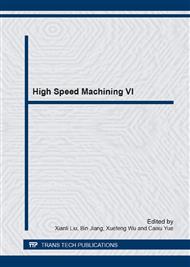p.590
p.596
p.601
p.607
p.613
p.619
p.627
p.633
p.639
Research on Surface Roughness in High Speed Face Milling Part 1: Theory of Prediction Model
Abstract:
The work-piece surface quality reflects the cutting performance of face-milling cutter. This paper presents the development of an algorithm to predict work-piece surface roughness in face milling operation. The prediction model is based on the face milling cutter fixed square inserts with flat edges. The static prediction model considers the effects of radial and axial run-out error of inserts, feed per tooth, tooth number, cutting edge length, nose radius, main lead angle, and axial depth of cut. The dynamic prediction model considers the effects of the Z-axial relative displacement between the work-piece and cutting teeth caused by forced vibration. By combining the prediction results of static and dynamic models, the surface roughness of the work-piece in face milling is predicted.
Info:
Periodical:
Pages:
613-618
Citation:
Online since:
July 2014
Authors:
Price:
Сopyright:
© 2014 Trans Tech Publications Ltd. All Rights Reserved
Share:
Citation:


